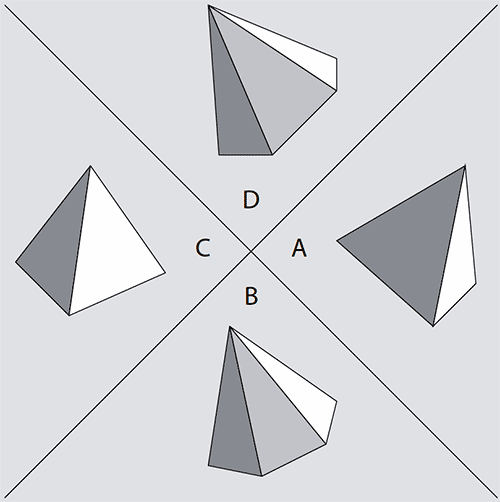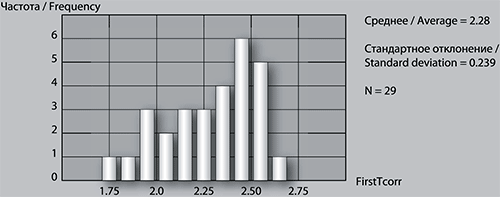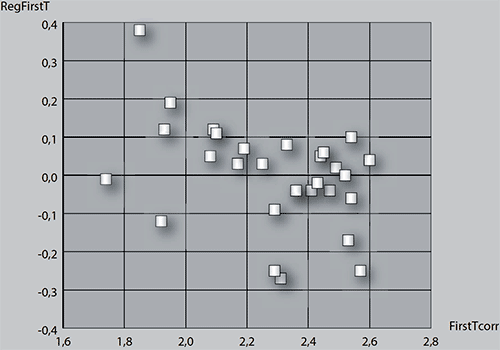Categorical search for three-dimensional shapes in participants with different level of mathematical expertise
Recieved: 02/03/2020
Accepted: 02/15/2020
Published: 03/31/2020
Pages: 57-65
DOI: 10.11621/npj.2020.0106
Keywords: categorical search; extrafoveal analysis; covert attention; pre-attentive processing; three-dimensional shapes; perceptual processes; visual search mechanisms; attention; interindividual differences
Available online: 31.03.2020
Dreneva Anna A. (2020). Categorical search for three-dimensional shapes in participants with different level of mathematical expertise. National Psychological Journal, (1) , 57-65. https://doi.org/10.11621/npj.2020.0106
Copied to Clipboard
CopyAbstract
Background. The paper considers the issue of categorical search for three-dimensional geometric shapes. The results of the previous studies on the real-world objects showed that pre-attentive extrafoveal analysis provides an effective identification of the target, reflecting in the right direction of the first saccade compared with the random search.
Objective. In this study, we investigated the efficacy of extrafoveal analysis during categorical search for pyramids in two groups of participants: mathematicians and psychologists.
Design. 15 mathematicians and 17 psychologists aged 18-25 participated in the study. Each participant performed 144 trialssearching for the target pyramid among the distractor pyramids. In the series 2and 9, any eye movements were prohibited to study covert attention.
Results. The findings of the experiment failed to reveal any differences in the use of extrafoveal analysis and accuracy in both groups. We observed dramatic individual differences, revealed in various degrees of extrafoveal analysis in the search process and in changing the strategy of the task solving. Special series which prohibited eye movements, demonstrated a significant role of covert attention in the categorical search, as well as the possibility and effectiveness of extrafoveal analysis even though while free instruction it could not be used by all participants and all cases.
Conclusion. During categorical search both foveal and extrafoveal processing of stimuli, as well as pre-attentive analysis and covert attention, were simultaneously involved. The dynamics of their interaction was determined by low-level perceptual processes, individual characteristics of the subjects, the task specificity and the instruction.
Tab. 1. Number of correct answers in groups of mathematicians and psychologists
|
Mathematicians ("experts") |
Psychologists ("freshers") |
||
|
Subject's initials |
Number of correct answers (%) |
Subject's initials |
Number of correct answers (%) |
|
V |
58,9 |
T |
50 |
|
A1 |
65,3 |
A4 |
50,7 |
|
M1 |
68,5 |
A5 |
54,9 |
|
A2 |
68,7 |
M3 |
55,2 |
|
A3 |
69,2 |
I |
56,6 |
|
Y |
69,9 |
M4 |
62,5 |
|
N |
70,6 |
D2 |
69,7 |
|
E1 |
72,1 |
V |
74,8 |
|
E2 |
72,9 |
E3 |
76,1 |
|
D1 |
74,1 |
M5 |
77,8 |
|
S |
90,2 |
K2 |
78 |
|
K1 |
91 |
A6 |
81,1 |
|
M2 |
93,1 |
A7 |
82,6 |
|
K3 |
82,6 |
||
|
A8 |
84 |
||
|
D3 |
85 |
||
|
Average |
74,2 |
Average |
70,1 |
|
Median |
70,6 |
Median |
75,45 |

Fig. 1. Sample stimulus slide

Fig. 2. Histogram of average FirstT indicators in subjects

Fig. 3. Relationship between the dynamics of the indicator FirstT and the average FirstT in subjects
Acknowledgments
The work was carried out as part of a research project under the RFBR grant “Extrafoveal analysis of visual stimuli given by mathematical concepts: the interaction of descending and ascending processes”. Contract N 18-013-00869
References
Chen X., & Zelinsky G.J. (2006). Real-world visual search is dominated by top-down guidance. Vision research, 46(24), 4118–4133. doi: 10.1016/j. visres.2006.08.008
Chumachenko D.V., & Schwartz A.Yu. (2016). The issue of transforming perceptual processes in training: analysis of studies performed by recording eye movements from the perspective of the activity approach [Psikhologicheskie issledovaniya: elektronnyy nauchnyy zhurnal], 9(49). 12–12. Retrieved from: http://psystudy.ru/num/2016v9n49/1329-chumachenko49
Deubel H. (2008). The time course of presaccadic attention shifts. Psychological research, 72(6), 630. doi: 10.1007/s00426-008-0165-3
Drenyova A.A. et al. (2019). Extrafoveal analysis of categorically defined three-dimensional figures. [Sibirskiy psikhologicheskiy zhurnal], 72, 68–92. 10.17223/17267080/72/4
Eckstein M.P. (2011). Visual search: A retrospective. Journal of vision, 11(5), 14–14. doi: 10.1167/11.5.14
Eckstein M.P., Drescher B.A., & Shimozaki S.S. (2006). Attentional cues in real scenes, saccadic targeting, and Bayesian priors. Psychological science, 17(11), 973–980. doi: 10.1111/j.1467-9280.2006.01815.x
Findlay J.M. (1997). Saccade target selection during visual search. Vision research, 37(5), 617–631. doi: 10.1016/S0042-6989(96)00218-0
Frömer R. et al. (2015). Are individual differences in reading speed related to extrafoveal visual acuity and crowding? PloS one, 10(3), / doi: 10.1371/ journal.pone.0121986
Gandini D., Lemaire P., & Dufau S. (2008). Older and younger adults’ strategies in approximate quantification. Acta psychological, 129(1), 175–189. doi: 10.1016/j.actpsy.2008.05.009
Gegenfurtner A., Lehtinen E., & Säljö R. (2011). Expertise differences in the comprehension of visualizations: A meta-analysis of eye-tracking research in professional domains. Educational Psychology Review, 23(4), 523–552. doi: 10.1007/s10648-011-9174-7
Goodwin C. (1994). Professional vision. American anthropologist, 96(3), 606–633. doi: 10.1525/aa.1994.96.3.02a00100
Henderson J.M., Weeks Jr P.A., & Hollingworth A. (1999). The effects of semantic consistency on eye movements during complex scene viewing. Journal of experimental psychology: Human perception and performance, 25(1), 210. doi: 10.1037/0096-1523.25.1.210
Krichevets A.N. et al. (2017). Opportunities of extrafoveal perception of geometric shapes. [Voprosy psikhologii], 6, 117–128.
Krichevets A.N., Shvarts A.Y., & Chumachenko D.V. (2014). Perceptual action of novices and experts in operating visual representations of a mathematical concept. [Psikhologiya. Zhurnal Vysshey shkoly ekonomiki], 11(3), 55–78.
Posner M.I. (1980). Orienting of attention. Quarterly journal of experimental psychology, 32(1), 3–25. doi: 10.1080/00335558008248231
Radford L. (2010). The eye as a theoretician: Seeing structures in generalizing activities. For the learning of mathematics, 30(2), 2–7. doi: 10.2307/20749442
Rosenholtz R., Huang J., & Ehinger K.A. (2012). Rethinking the role of top-down attention in vision: Effects attributable to a lossy representation in peripheral vision. Frontiers in psychology, 3(13). doi: 10.3389/fpsyg.2012.00013
Schmidt J., & Zelinsky G.J. (2009). Search guidance is proportional to the categorical specificity of a target cue. The Quarterly Journal of Experimental Psychology, 62(10), 1904–1914. doi: 10.1080/17470210902853530
Schmidt J., Zelinsky G.J. (2011). Visual search guidance is best after a short delay. Vision Research, 51(6), 535–545. doi: 10.1016/j.visres.2011.01.013
Treisman A. M., & Gelade G. (1980). A feature-integration theory of attention. Cognitive psychology, 12(1), 97–136. doi: 10.1016/0010-0285(80)90005-5
Vickery T.J., King L.W., & Jiang Y. (2005). Setting up the target template in visual search. Journal of Vision, 5(1), 8–8. doi: 10.1167/5.1.8
Williams D.E. et al. (1997). Patterns of eye movements during parallel and serial visual search tasks. Canadian Journal of Experimental Psychology/ Revue canadienne de psychologieexpérimentale, 51(2), 151. doi: 10.1037/1196-1961.51.2.151
Wolfe J.M. et al. (2004). How fast can you change your mind? The speed of top-down guidance in visual search. Vision research, 44(12), 1411–1426. doi: 10.1016/j.visres.2003.11.024
Wolfe J.M. (1998). What can 1 million trials tell us about visual search? Psychological Science, 9(1), 33–39. doi: 10.1111/1467-9280.00006
Yang H., & Zelinsky G.J. (2009). Visual search is guided to categorically-defined targets. Vision research, 49(16), 2095–2103. doi: 10.1016/j. visres.2009.05.017
Zelinsky G.J. et al. (1997). Eye movements reveal the spatiotemporal dynamics of visual search. Psychological science, 8(6), 448–453. doi: 10.1111/j.1467- 9280.1997.tb00459.x
Zelinsky G.J. et al. (2013). Modelling eye movements in a categorical search task. Philosophical Transactions of the Royal Society B: Biological Sciences, 368(1628). doi:10.1098/rstb.2013.0058
Zelinsky G.J., & Schmidt J. (2009). An effect of referential scene constraint on search implies scene segmentation. Visual Cognition, 17(6–7), 1004–1028. doi: 10.1080/13506280902764315
Zelinsky G.J., & Sheinberg D.L. (1997). Eye movements during parallel–serial visual search. Journal of Experimental Psychology: Human Perception and Performance, 23(1), 244. 10.1037/0096-1523.23.1.244
Zhang L. et al. (2008). SUN: A Bayesian framework for saliency using natural statistics. Journal of vision, 8(7), 32–32. doi: 10.1167/8.7.32
Dreneva Anna A.. Categorical search for three-dimensional shapes in participants with different level of mathematical expertise. // National Psychological Journal 2020. 1. Pages57-65. doi: 10.11621/npj.2020.0106
Copied to Clipboard
Copy

